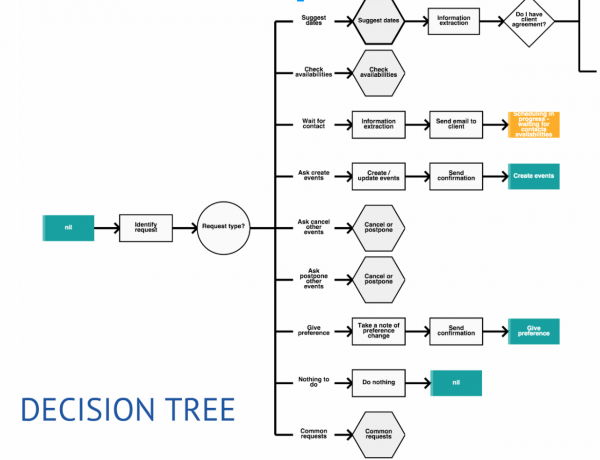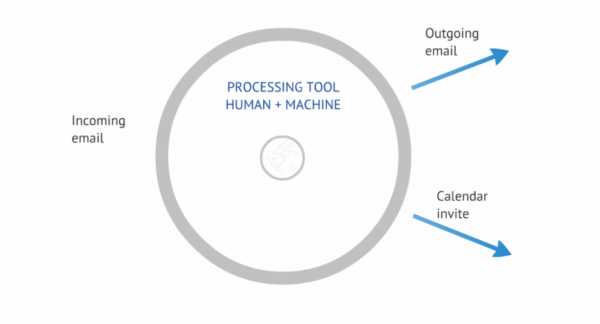This article is an updated version and was originally published on november 2016.
“Julie who is CC’d in this email will contact you to schedule the meeting”
Ah! Where would we be without her? Even though she is an integral part of your daily life, we haven’t really taken the time to fully introduce her to you have we? Let’s fix this right now: come discover what goes on behind the scenes of Julie through this infographic display. You can print it and showcase it above your desk, share it with your friends… the possibilities are endless.
A self-aware intelligence…
If we go back to the definition and origins of the term intelligence, Wikipedia, the king of definitions tells us this:
“The term derives from the latin verb intelligere ( “ability to understand”), whose prefix “ inter- ” ( “between”) and stem legĕre (“to collect, to gather) or ligare (“to bind, to unite”) essentially suggest the ability to bind elements with one another.”
Indeed, the main challenge that Julie faces is to succeed in combining the different elements found in the emails she receives so that she can not only understand them but also process them successfully. This explains why she requires her own thinking capacity, developed through artificial intelligence (AI) and particularly the two following features:
- Natural Language Processing (NLP): A set of technical computing programs and techniques that the human language goes through. This process allows Julie to “link together all the elements” in your emails in the aim of understanding them.
- Machine Learning: This assembles a set of algorithms that allow the machine to understand the data. This process is carried out in three phases: the learning process, data modeling, the evaluation, measuring the gap between the model and reality, and finally the optimization, reducing the measured gap. Due to Machine Learning and human supervision, Julie can process the data retrieved from emails and therefore carry out the different actions.
Want to know more about NLP and Machine Learning concepts as well as how Julie carries them out? Read “How Natural Language Processing (NLP) gave birth to Julie” by Ferdinand Roth.
 A large number of computing programs exist inside Julie’s core but that’s not the end of it. All these programs have to be created and modeled by humans. The way we interact in society and in this particular case, the way we schedule our different appointments respond to a specific set of well established codes transmitted between generations and therefore must also be transmitted to machines.
A large number of computing programs exist inside Julie’s core but that’s not the end of it. All these programs have to be created and modeled by humans. The way we interact in society and in this particular case, the way we schedule our different appointments respond to a specific set of well established codes transmitted between generations and therefore must also be transmitted to machines.
In Julie’s case, all three founders initially “divided” the appointment scheduling process into several steps. In other words, they analyzed the act of scheduling a meeting in all its little steps. To do so and to fully understand how scheduling a meeting works, they, themselves, took upon the role of assistants 24/7 for a duration of 6 months and came up with the following steps:
- New request
- Answer questions WHO? WHAT? WHEN? WHERE?
- Who is making the request?
- What is the request?
- When will the appointment take place?
- Where will the appointment take place?
- Make the appointment
- Send available dates
- OR send an invitation for the appointment
Each step is divided into sub-steps, precisely in sub-questions to which Julie must find an answer in order to move forward in her decision tree and finally carry out one of two actions: Send an email OR create a new event in the agenda.

Excerpt from Julie Desk’s decision tree
In the end, Julie’s AI brain contains 4 main components:
- Human expertise – It informs Julie about the different human codes and steps referring to the appointment scheduling ( we will go more in depth later).
- Database – It ”feeds” Julie with the different models she uses so that she can successfully test and integrate the scenarios that she was taught.
- Machine learning
- Natural language processing
It is evident here that the human component is essential to the development of an AI.
… And a great expertise
The different blocks integrated into Julie’s core allow her to develop a whole set of skills and know-hows that are essential to an efficient virtual assistant when it comes to appointment scheduling.
Let’s analyze in depth all these know-hows.
Information retrieval
In order to understand the emails that she receives, Julie needs to fully “understand their meaning”. For that to happen, she carries out several information retrieval tasks such as:
- Syntactic Parsing: analyzing a chain of characters, either in natural language or computer language and in accordance with predefined grammatical rules.
- Name Entity Recognition: the aim here is to identify named entities and to classify them in various defined categories.
Here is an example to illustrate this:
“I would like to schedule a meeting with Julien for Friday 16th July 2017 at 2.30pm in his office”
The following “Friday 16th July”, “2.30pm”, “in his office” are respectively named entities of date, time and location.
- Pos-tagging: this process consists of associating the words in a text to their corresponding grammatical information. For example, the grammatical category of the words (verb, adjective, common noun, etc.), their genre (masculine, feminine or neutral depending on the language) and their number (singular or plural), etc.
Automatic Classification
As mentioned in our previous post How NLP gave birth to Julie, to allow her to process the requests she receives, we have defined several tags linked to appointment scheduling that she has to associate with each request: “Lunch”, “Call”, “Interview”, “Meeting”… Julie uses around ten tags to categorize the appointments that she processes. Each one corresponds to a different type of appointment.
This classification allows for Julie to assign these various tags to the data she receives and extracts from emails.
Bilingualism
Did you know that Julie is bilingual? She understands English just as well as she understands French. Once you understand the complexity of all the different analysis and information extracting processes, you quickly realize that being bilingual isn’t irrelevant, especially where NLP is concerned.
Constant learning
Just like we learn from our experiences, successes and failures, Julie also needs to continuously learn and evolve through feedbacks from not only her users but also her “coaches” who are our operators. As we have mentioned before, it is also a part of the learning process.
The big difference that exists between Julie and other intelligent agents is that we do not believe in a 100% automatic technology to manage the appointment scheduling: language constitutes such an immense and complicated field and more often than not, we tend not to act in a logical manner. At this point in time, it is difficult, if not impossible for a machine to respond to 100% of a user’s requests without making any kind of mistake. On the contrary, we believe in combining both humans and machines to create efficient and increasingly powerful models and thus revolutionize the role we play in society and the way we live.
In that sense, Julie is a supervised intelligence.
Each action carried out by Julie is submitted to operators who will complete, correct and validate it. There are like teachers who give out an average grade. That way, Julie is able to understand how she conducted her task well and continually seek to improve herself. This is the last step we mentioned in Machine Learning, the optimization step.

Machine Learning – the Optimization step
The more you use Julie, the more she improves 🙂
But what about the security of my data?
As you may have noticed, data plays a key role in the process of machine learning. But rest assured, Julie won’t be doing whatever she wants with your data!
What is the data stored by Julie Desk?
When you sign up for Julie Desk, you connect her to your calendar. This means that you give Julie the right to read and write on your calendar. Julie can also see the times that you are available and program your meetings depending on your availability (and your preferences of course).
In order to make these requests to Julie, you will have to send her the information by email or by putting her on copy of an email. These emails are also archived. We only have access to the information you have decided to send or transfer to Julie and only archive emails that she receives directly from you. In the same vein, we have no access to your inbox or contacts.
Where is the data stored?
We work with OVH, certified ISO27001. We house our services and data in a dedicated database in France.
We are also in the process of obtaining a ISO27001 certification and are working on conforming to the new GDPR regulation (in place by May 2018).
Who has access to the data?
Julie:)
As mentioned before, Julie is a supervised AI program. Julie’s “coaches,” the operators we mentioned, have access to the data. Access to data is controlled and only possible under certain conditions. To learn more, contact us.
What is the data for?
Julie uses the data for two things:
- To carry out your requests
- To better her performance
To learn more about data management and security at Julie Desk, check out our Terms and Conditions or contact our team!
And if you wish to deepen your knowledge on these topics of AI and the way Julie works, feel free to contact our AI expert Ferdinand Roth. And since they are respectively gardening and Basketball experts, they can also give you some insight on your gardens or the perfect dunk 🙂
Find all the details of this post in our infographic display! Do not hesitate to share it (Don’t forget to tag us :))

For more information or comments, feel free to visit our FAQ page or contact our team.
![Julie: Behind the scenes! [Infographic]](https://blog.juliedesk.com/wp-content/uploads/2017/02/featuredimageblog_julie_behindthescenes.png)